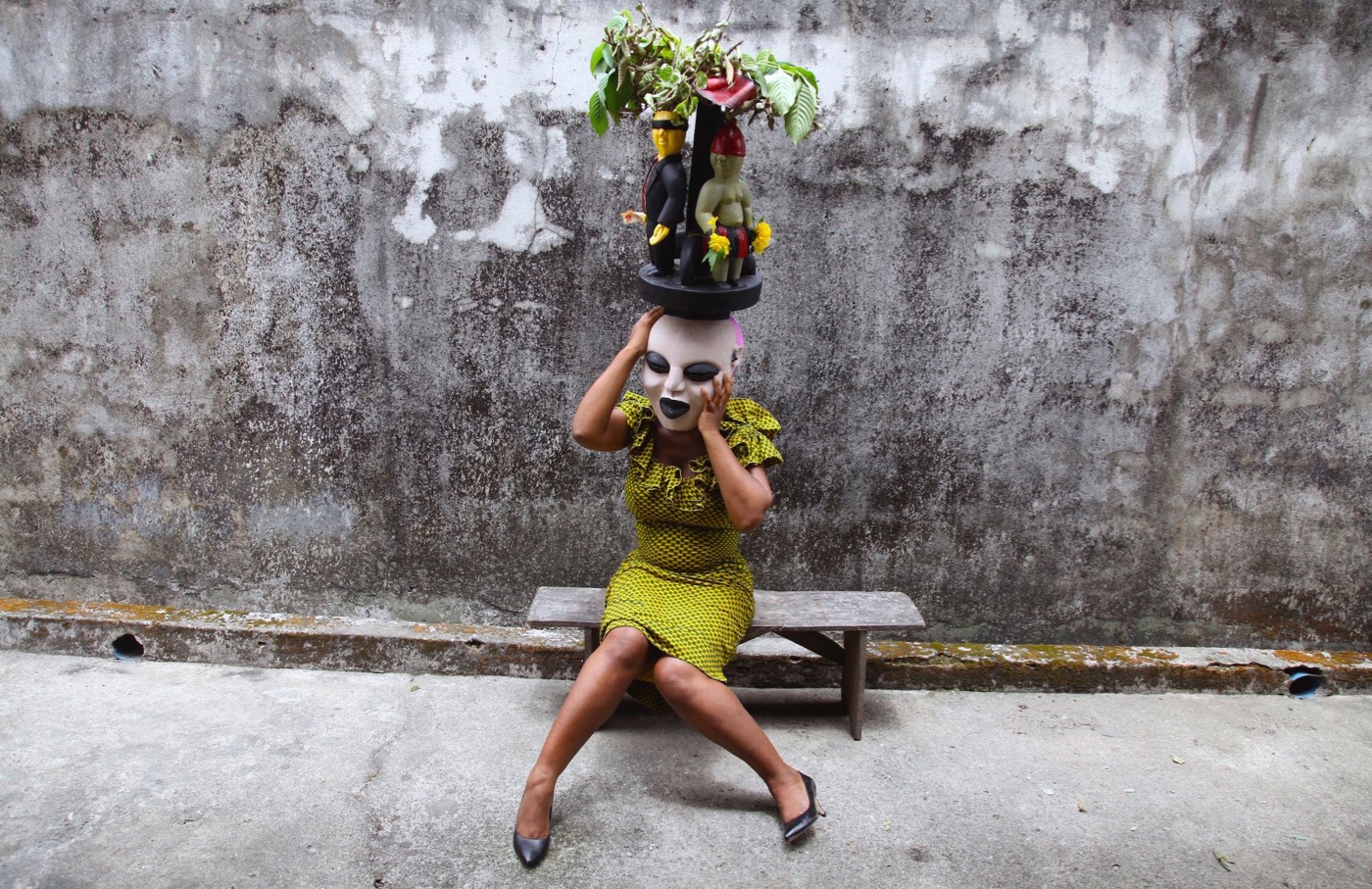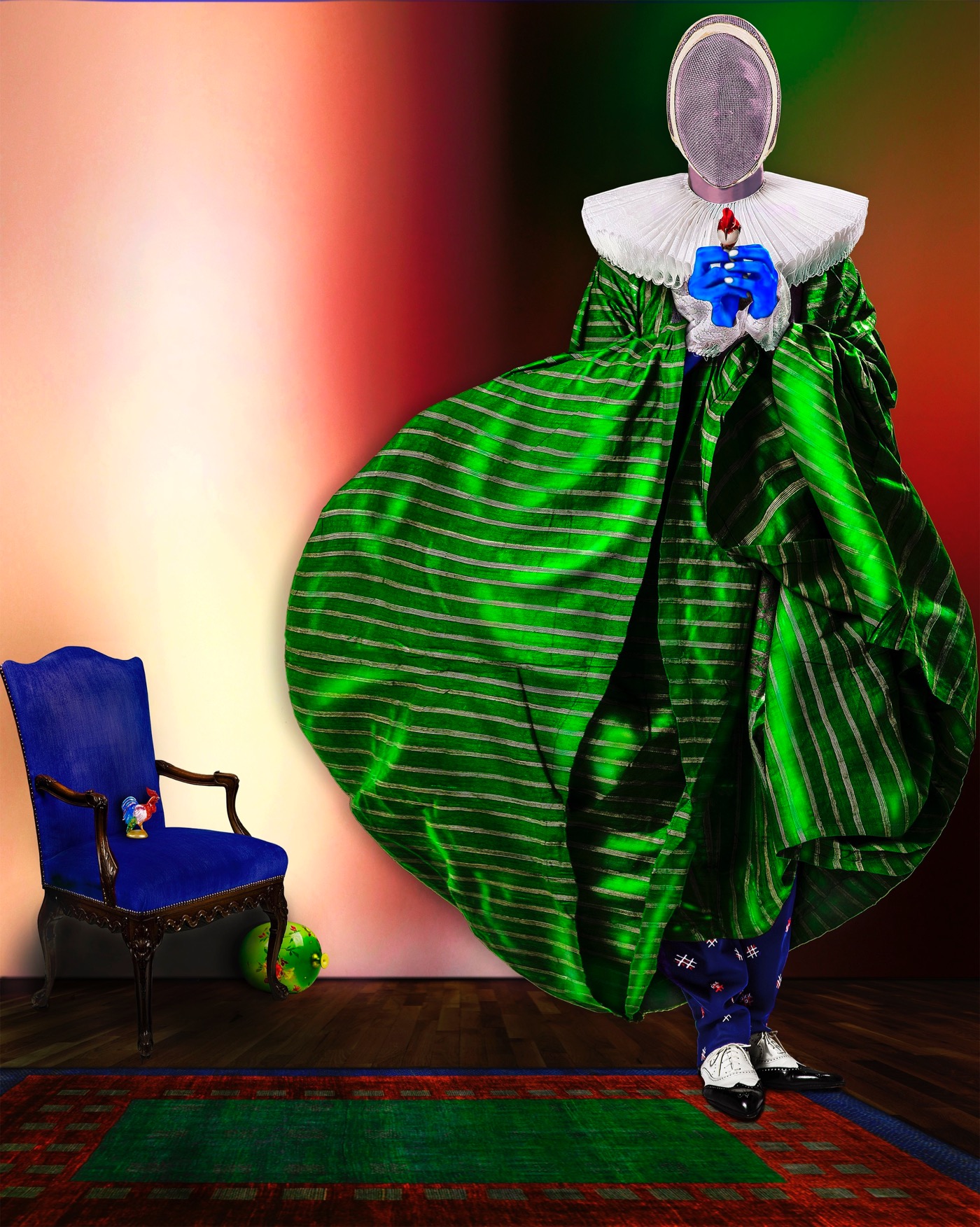The show ostensibly seeks to rehistoricize masks as aesthetic objects that are not meant merely for display or concealment, but are also used within a performance context; it attempts to connect contemporary performance practice to objects created in the last century among tribes around the African continent

Installation view, ‘Disguise: Masks and Global African Art’ at the Brooklyn Museum (photo © Johnathan Dorado) (click to enlarge)
Masks present a quandary. It’s not so much what they’re hiding that I wonder about, but what the camouflage or costuming is meant to produce in me. I got together again with my friend Nile Davies — a PhD candidate in Columbia University’s department of Middle Eastern, South Asian, and African Studies — to investigate, as we have done before, the exhibition Disguise: Masks and Global African Art at the Brooklyn Museum. The show ostensibly seeks to rehistoricize masks as aesthetic objects that are not meant merely for display or concealment, but are also used within a performance context; it attempts to connect contemporary performance practice to objects created in the last century among tribes around the African continent. The show is so complex and sprawling, we had to see it twice to fully make sense of what was happening. What follows is an edited version of our conversation.
* * *

Installation view, ‘Disguise: Masks and Global African Art’ at the Brooklyn Museum (photo © Johnathan Dorado) (click to enlarge)
Seph Rodney: We’re at the Brooklyn Museum today, and we’re going to talk about Disguise.
Nile Davies: Disguise, masks, and global African art, maybe?
SR: Sounds right. This is our second time with this show. The first time I was kind of overwhelmed; it was hard for me to get a handle on what was going on. Now I think I do have a handle. I walked through the show this time, and I thought about the concern around seeing masks as not separated from performance. Part of what was said on the wall text was that masks are actually the endof that process by which performance and other activities interpret internal and global pressures. It’s trying to get away from that narrative about African masks that makes them fetishized objects. Seems like the curators want to inject life back into this historical object. They know it’s about performance, and that you can see the same kind of performance now in contemporary art, and I like that.
ND: I read it as a meditation on the mask as a metaphor: this kind of internality/externality, the idea of being able to project a psychological aspect. One of the pieces and one of the wall texts spoke about the idea of the mask as a temporary becoming, like a physical transformation.
SR: That’s the thing: there were several things going on at the same time. They want to connect African masquerade to contemporary practices. They want to say that masks aren’t separate from performance, that you have to see them as connected in order to get their critical import …

Installation view, ‘Disguise: Masks and Global African Art’ at the Brooklyn Museum (photo © Johnathan Dorado) (click to enlarge)
ND: But where is the performance? This is my bugbear that I’m still trying to figure out.
SR: That’s a fair question. There was, though, a lot of work documenting performance. Like “Oikonomos,” by Edson Chagas, the artist with the bags over his head. I think, OK, you’re not really doing a performance, but in that moment, when he has that silly Barack Obama bag over his head, he is taking on the persona of someone else. So it’s kind of kitschy and funny, but it also does get at what it is to channel some other force of being.
ND: Sure, and the South African artist with the big cowhide [Nandipha Mntambo, “Umfelokati Wenhlaba (Widow of the Earth)” (2014)].
SR: I really responded to the video “Double Quadruple Etcetera Etcetera I and II” [by Sondra Perry, (2013)], where it’s just a head shaking and the body’s whited out. There’s performance.
ND: Yeah. But I think it’s much more difficult to locate when you have these static objects …
SR: Because basically you just have a trace. You have a documentary object.
ND: It’s completely withdrawn from its context. If it’s supposed to suggest performance, it doesn’t actually. It’s very hard to read.

The Nguabu Master (Mende), “Helmet Mask for Sande Society (Ndoli Jowei),” (late 19th–early 20th century); Nguabu, Moyamba district, Southern province, Sierra Leone; wood, pigment; 15 1/2 x 9 1/4 x 10 1/4 in; Brooklyn Museum (photo courtesy Brooklyn Museum) (click to enlarge)
ND: It’s really interesting as well, because this is the second show at the Brooklyn Museum on masks. The first one was in 1939.
SR: Really?
ND: At the beginning they have a few choice pieces from that exhibit, which was calledMasks: Barbaric and Civilized.
SR: Wow, they’ve come a long way.
ND: Exactly. It’s fascinating to see the differences. I think that was more anthropological …
SR: And ever so slightly racist.
ND: Goes without saying. [That show included masks] from Africa, from the Pacific and Asia, Native American, European masks even, which is definitely something you don’t see in this exhibit in 2016. This goes with the narrative that masks are particularly African, not necessarily a globally practiced tradition — which they are. I wonder what the decision was in making it Africa-centric this time around. Even though the “Barbaric and Civilized” show said that the other ones were barbaric in comparison, it did at least examine the whole range of mask-making tradition and practice, from everywhere. Though it’s debatable what the effects of that are.
SR: This is one of the things that I appreciated with Disguise: how they were trying to make a connection between these 18th-, 19th-century masks and contemporary performance practice, and talk about how, with the contemporary turn, you get to interrogate issues around gender. So, you have women using the masks, disguise, props to cross over into male territory, to find out what the men are doing.
ND: Also into traditionally male roles as well. There was a video where the artist [Zina Saro-Wiwa, “The Invisible Man: The Weight of Absence” (2015)] made the case that this is a traditionally male role, because of the weight of the masks being too heavy for women to carry on their shoulders. So, doing that, she is upsetting the patriarchal aspect of masquerade tradition.

Zina Saro-Wiwa “The Invisible Man: The Weight of Absence” (2015), pigmented inkjet print, 28 in x 44 in, Seattle Art Museum, Commission, 2015 (photo courtesy the artist, © Zina Saro-Wiwa)
SR: I like that. I think it was brilliant for them to make that turn with the show, so it becomes clear that even within masquerade practice there are clear boundaries, and those boundaries are now getting challenged and pushed.
ND: Can we talk about the Chimera room [Saya Woolfalk “ChimaTEK: Virtual Chimeric Space” (2015)]? I found that I was there for half an hour.
SR: That piece, while it’s visually vivid and really active, I’m not sure what it’s meant to do, aside from showing a mash-up of a range of traditions.
ND: The whole narrative behind it is fascinating: a fictional company that enables very wealthy people to get a new hybridized avatar or identity. I found it troubling how they [the artist in the guise of a corporation] talked about boundaries shifting, about these old Sande masks from Sierra Leone and how they harness that power, or take that ethos of shapeshifting, and use it for their own practice. It’s high-tech post-human hybridization. Isn’t that just plain appropriation?

Installation view, ‘Disguise: Masks and Global African Art’ at the Brooklyn Museum (photo © Johnathan Dorado) (click to enlarge)
SR: I’m loathe to use the term appropriation. For me — and this is an odd position for me to take — it hinges on intentionality. I cannot know the author’s intention in this case. I will say this: there’s something about that post-human discourse that’s always trying to get beyond the responsibility of identity politics. It’s always trying to defer having to show up and say something meaningful and be clear with people about what it is, who they’re dealing with. I think I can appreciate what the post-human promise is, which is this space of ethnic and gender fluidity, of not necessarily being compartmentalized, but it’s a difficult, problematic position.
ND: Whether you need the prop of old African masks from Sierra Leone as a tool to achieve that, as in this case, is somewhat debatable. It’s giving it some sort of historical heft, putting it in the context of a tradition that pre-exists. I just mean, why? It seems pretty arbitrary to me. Why these masks and not masks from anywhere else in the world?
SR: That’s a good question. So do you think this exhibition could have worked with masks from the Solomon Islands?
ND: Exactly. An anthropologist would have been interested to see the connections between different mask-making practices from around the world. Or at least their interpretation by artists. I don’t know why it’s the African masks time and again. It’s a very rich tradition with a lot of cachet, but I wonder if it’s our kind of Orientalism.


Ikè Udè, “Sartorial Anarchy #23,” (2013), pigmented inkjet print, 46 x 37 in (photo courtesy the artist and Leila Heller Gallery, New York, © Ikè Udè)
Disguise: Masks and Global African Art continues at the Brooklyn Museum (200 Eastern Parkway, Prospect Heights, Brooklyn) through September 18.
Comments
Post a Comment